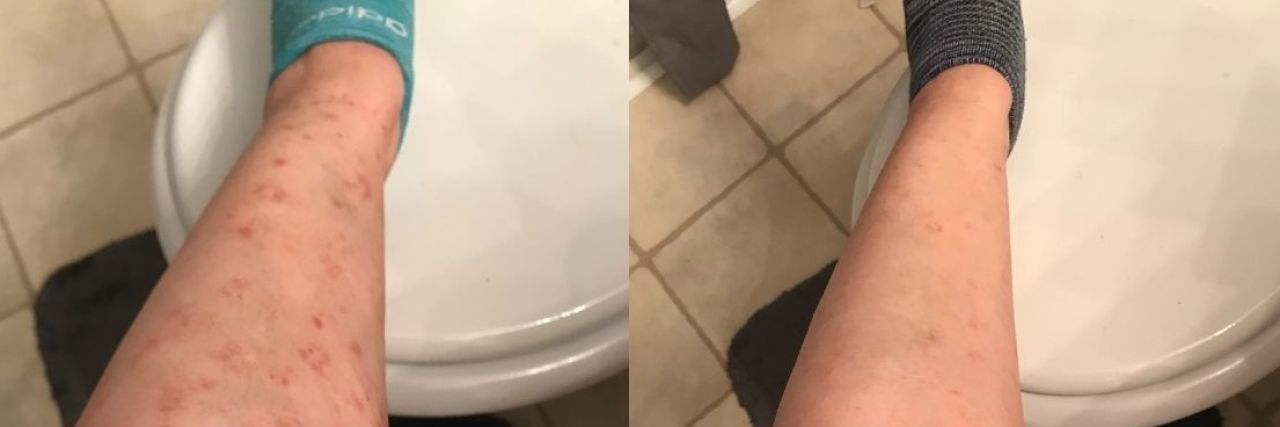6 Tips That Help Me Manage My Chronic Skin Condition
Editor's Note
Any medical information included is based on a personal experience. For questions or concerns regarding health, please consult a doctor or medical professional.
As a published author, I thought my third book might center around living with PLC (or pityriasis lichenoides chronica) — a diagnosis I received in my teens and have lived with ever since. The chronica implies that I will have spotted skin (seasonally reddish or white) as long as I am alive. As I began researching again, the 1 in every 2,000 people per year affected was a bit intimidating. If I do write this book, who is going to read it?
Thus, we find ourselves here, friends. Earlier this year, I experienced nothing short of a miracle. After going through most of my life not personally knowing a single other soul that shared my PLC diagnosis, one showed up in the most unlikely of ways. I shared my diagnosis via social media. As a writer, I believe in honesty and transparency with my audience, but I had never directly shared my skin condition.
A dear friend responded with, “You have PLC?! So does Anissa (her daughter)!” I sat there looking at the response, stunned. Anissa, now a high school senior that I’ve known since she was a little girl, was soon to be my piano student. Since then, we have bonded over many PLC stories and exchanged advice. She is about 20 years younger than me and deals with the condition with much more grace and wisdom than I did at her age. Below, I have compiled a list of insider secrets to living with — and managing — pityriasis lichenoides chronica:
1. Take helpful supplements.
I personally take Bromelain, a natural supplement that comes from pineapple, daily (I buy in bulk on Amazon). While I still have white, discolored patches of skin during this fall season, it seems to help keep the red bumps at bay, or at least, manageable. I learned about this supplement in the PLC Facebook support group I joined a couple of years ago (look it up!).
2. Try changing up your diet.
I’ve tried cutting gluten and dairy out of my diet. Arguably the best “soft as a baby’s bottom” skin results I have seen were directly after eliminating these food items from my rotation. The only problem? They are some of my favorite foods. If you are in a desperate place with your PLC, start here first. I promise it’s worth it.
3. The sun, sand and saltwater are your friends.
If you don’t have easy access to a beach, try bathing with Epsom salt, which is also effective. My favorite thing to do is exfoliate my skin with sand, rinse off in the ocean and get a safe amount of sun while lathered in sunblock.
4. Find an eating schedule that works for you.
I’ve personally been trying intermittent fasting. This popular trend that I started just eight weeks ago seems to have positively affected my largest organ, too! I eat within an eight-hour block during the day (typically noon to 8 p.m.). Since I’m asleep for most of the other hours, it’s been super manageable.
5. Prescribed topical ointment.
My favorite brand is Triamcinolone Acetonide Cream, 0.1%. I resort to this prescribed, topical ointment only when I have a bad breakout (this usually happens in winter, between December and February). Your dermatologist can prescribe this if you don’t already own it. Fair warning: excessive use over the years can lead to your skin thinning.
6. Celery juice.
Chances are you’ve heard of the effects of celery juice. Next to modifying my diet, drinking 16 oz of this juice every morning (that I typically cut with an apple) was the most successful in giving me mostly clear skin.
I typically do one or two of these things at a time to manage my PLC. It depends on what season (literally and figuratively) I find myself in. If you are someone who struggles with PLC or a different chronic skin condition, I would love to hear about what has worked for you (and I would love to hear if you try any of these approaches and how it goes). Until then, go forth in confidence, sharing your journey with one person at a time.

